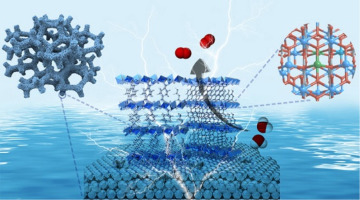Nano Energy ( IF 16.8 ) Pub Date : 2019-11-15 , DOI: 10.1016/j.nanoen.2019.104296 Liang Huang , Ge Gao , He Zhang , Jinxing Chen , Youxing Fang , Shaojun Dong

|
Two-dimensional metal-organic frameworks (MOFs) are promising earth-abundant electrocatalysts, especially for the key process of oxygen evolution reaction (OER), but challenges remain in the lack of effective synthesis and stabilization strategies. Here we first develop a general self-dissociation-assembly (SDA) strategy for in situ synthesis of well-defined ultrathin CoNi-MOF nanosheet arrays (CoNi-MOFNA) as highly active OER electrode. Remarkably, CoNi-MOFNA exhibit excellent OER activity and long-term stability, which deliver the current density of 10 mA cm-2 at a low overpotential of 215 mV with negligible decay even after 300 h continuous electrolysis. The mass activity of CoNi-MOFNA is 14-times higher than commercial RuO2. In addition, the systematic electrochemistry and time-dependent XAS spectroscopy studies convincingly identify the OER active sites of coordinatively unsaturated metal nodes and uncover the structure evolution of CoNi-MOFNA. More importantly, we have demonstrated the universality of this significant SDA strategy for controllably fabricating other types of ultrathin MOF nanosheet arrays uniformly on diverse metal substrates.
中文翻译:

超薄金属-有机骨架纳米片阵列的自离解组装,可有效释放氧气
二维金属有机框架(MOF)是有前途的地球上富裕的电催化剂,尤其是对于氧释放反应(OER)的关键过程而言,但仍然缺乏有效的合成和稳定策略。在这里,我们首先开发一种通用的自解离组装(SDA)策略,用于原位合成明确定义的超薄CoNi-MOF纳米片阵列(CoNi-MOFNA)作为高活性OER电极。值得注意的是,CoNi-MOFNA具有出色的OER活性和长期稳定性,即使在连续电解300小时后,在215 mV的低过电势下仍可提供10 mA cm -2的电流密度。CoNi-MOFNA的质量活性是商业RuO 2的14倍。此外,系统的电化学和随时间变化的XAS光谱学研究令人信服地确定了不饱和配位金属节点的OER活性位点,并揭示了CoNi-MOFNA的结构演变。更重要的是,我们已经证明了这种重要的SDA策略的普遍性,该策略可控地在各种金属基材上均匀地制造其他类型的超薄MOF纳米片阵列。


















































 京公网安备 11010802027423号
京公网安备 11010802027423号